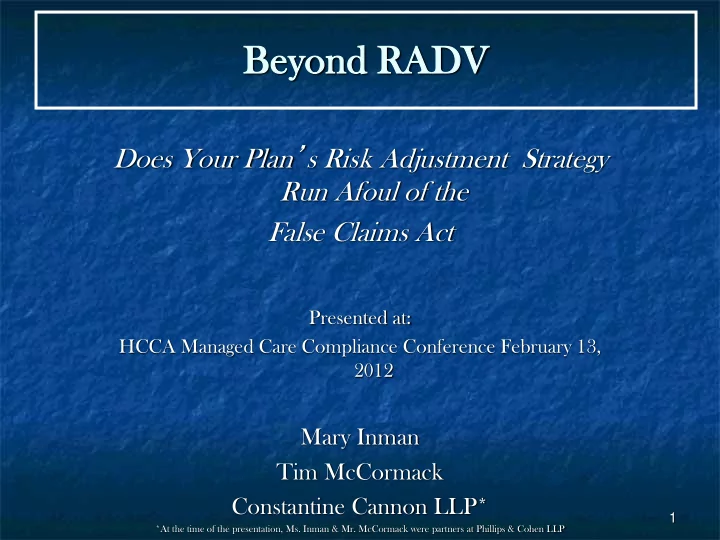

Be Beyo yond nd RADV DV Does Your Plan ’ s Risk Adjustment Strategy Run Afoul of the False Claims Act Presented at: HCCA Managed Care Compliance Conference February 13, 2012 Mary Inman Tim McCormack Constantine Cannon LLP* 1 *At the time of the presentation, Ms. Inman & Mr. McCormack were partners at Phillips & Cohen LLP
Overview of Risk Adjustment Fraud Risk adjustment fraud is essentially “ upcoding ” for diagnosis codes Traditional Upcoding: doctors and hospitals, paid by the procedure, claim payment for procedures they did not truly perform, or for a more complex version of the procedure they did perform Risk Adjustment Upcoding: Medicare Advantage ( “ MA ” ) HMOs, paid in large part by their members ’ health status, claim payment for diagnoses they do not have/were not treated for 2
Principles of Risk Adjustment 3
Principles of Risk Adjustment CMS pays Medicare Advantage HMOs on a capitated basis Per-member-per-month CMS recognizes, however, the risk HMOs take by agreeing to insure beneficiaries for a flat monthly fee A single hospitalization costs an average of $10,000 and can wipe out the Medicare premiums the HMO received that year 4
Principles of Risk Adjustment To help HMOs manage their risk, CMS created a system that increases its premium for beneficiaries who are receiving treatment for diseases that typically correspond to high costs The additional money comes in the form of an increased capitation rate: Member ’ s Capitation Rate = (The HMO ’ s Base Capitation Rate) x (The Member ’ s Risk Adjustment Multiplier) 5
Example: 76-year-old female with diabetes and renal failure Condition HCC Adjustment Female, 76 0.468 Diabetes (no 19 0.162 complications) Renal failure 131 0.368 Total 0.998 Base PMPM Multiplier Adjusted PMPM $800 0.998 $798.4 6
Requirements for Risk Adjustment Claims The patient must have been treated that year Face-to-face By a qualifying provider 7
Requirements for Risk Adjustment Claims CMS has rigid requirements about how plans qualify for increased risk adjustment payments The diagnosis codes must be documented in the medical record, following standard industry guidelines (ICD-9-CM) The diagnosis codes must stem from a face-to-face encounter between the physician and the patient 8
Requirements for Risk Adjustment Claims To ensure these goals are met, CMS requires HMOs to follow its guidance as to what diagnosis codes they submit For example: HMOs cannot submit diagnosis codes taken from certain types of medical records, such as radiology and lab reports, because the records do not reflect a face-to-face physician encounter 9
Risk Adjustment Fraud and the False Claims Act 10
Risk Adjustment and the False Claims Act The False Claims Act prohibits: knowingly presenting (or causing to be presented) to the a) federal government a false or fraudulent claim for payment or approval; and knowingly concealing or knowingly and improperly b) avoiding or decreasing an obligation to pay or transmit money or property to the Government. 31 U.S.C. §§ 3729(a)(1). 11
Risk Adjustment and the False Claims Act Any person who violates the FCA is liable for a civil penalty of up to $11,000 for each violation, plus three times the amount of the damages sustained by the United States. 31 U.S.C. § 3729(a)(1). 12
Each Diagnosis Submitted to CMS is a Claim for Payment With every diagnosis, HMOs submit information to CMS asserting the member has the diagnosed condition and received treatment for it: The member ’ s Health Insurance Claim ( “ HIC ” ) number; The ICD-9-CM diagnosis code The “ service from ” date and “ service through ” date The provider type 13
Risk Adjustment and the False Claims Act Each risk adjustment claim is itself a false statement, if the diagnosis is unsupported No separate certification is required to establish falsity That being said . . . 14
Medicare Advantage HMOs must attest to the accuracy of their risk adjustment data on an annual basis. 15
United States v. Janke 16
United States v. Janke, 09-CV-14044-Moore-Lynch (S.D. Fla. Feb. 10, 2009) Settled for $22.6 million in November 2010 17
United States v. Janke MA plan used coding reviewers to submit diagnosis codes to CMS that were not documented in the medical record or supported by an actual medical condition Data sweeps to find additional codes MA plan submitted codes via an automated system that could not delete unsupported or false claims Example (Freedom): reviewers are unable to submit delete codes when they find erroneous data (there is an “add” function, though) 18
United States v. Janke, 09-CV-14044-Moore-Lynch (S.D. Fla. Feb. 10, 2009) CMS Extrapolated Audit Results to Assess Damages from Risk Adjustment Fraud 19
Areas of Risk for the Submission of False Risk Adjustment Claims 20
Causes of False Claims: Affirmative Upcoding Simple fraud – “ making it up ” 1. Exaggerating severity of patient ’ s condition (e.g., 2. depression, malnutrition) 3. Claiming current treatment of condition (e.g., stroke, cancer) instead of past history of treatment 4. Claims based on laboratory, radiology or other improper provider or service type 5. Improperly linking complications and conditions 21
Causes of False Claims: Business Practices and Systemic Causes of Falsity 1. Failure to coordinate w/ Fraud and Abuse Department 2. Conducting chart reviews or other audits that only look for new risk adjustment claims 3. Failure to properly filter data used to generate risk adjustment claims 4. Compliance risk due to incentives to providers and failure to monitor provider submissions 5. Compliance risk due to vendor business methods and incentives 22
Recommend
More recommend